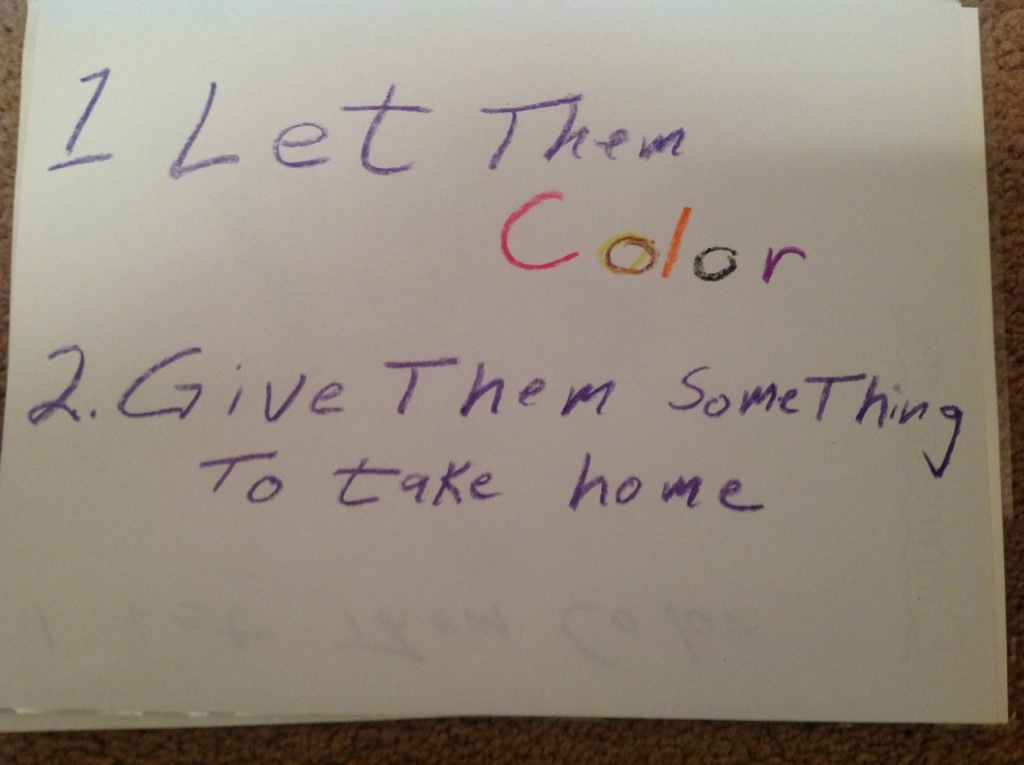The Two Rules of Training

I’ve been a trainer or a teacher for most of my life. Even when my official job title was Program Manager, or Vice President, or Consultant, there was always an element of training to every job. Add in volunteer opportunities as a scoutmaster, missionary, and of course years as a father to a large family, and the teaching moments have been nearly constant. Fortunately, it’s one of my greatest joys in business; getting to train people.
I discovered there are really two critical rules to training. . .whether you are teaching four year olds in pre-school, or 50 year olds in a corporate training course.

And with just a little bit of imagination, you can apply these lessons to virtually any training opportunity.
Let Them Color
Anyone who has taught a group of pre-teens for more than 15 minutes knows the value of crayons. “Okay, enough of the story. LET’S COLOR!”
Obviously, I’m not suggesting you bring crayons into your next team meeting. (Although, there are times when you should.) But, as a general rule, “professionals” feel like we’ve outgrown the crayon attraction.
I wrote training classes for Microsoft. These courses were often designed to be presented over anywhere from 3 to 10 days. However, even a one day training courses has to rely on more than a property-page crawl, or Death-by-PowerPoint. Typically in our courses we aimed for a 30/70 split. In other words, thirty percent lecture and seventy percent labs. (The labs are the “coloring” part.) It’s amazing how few courses follow this rule. If anything the percentages are often reversed, that’s if there’s a lab portion at all.
The most successful course I ever created taught Microsoft Support Engineers to decipher the network traffic between a computer running an email client (Microsoft Outlook) and an email server (Microsoft Exchange.) The course was three days long. We spent the first hour of the first day in PowerPoint and then abandoned it for good. The course was all about doing the labs.
One of my instructors would promise her class that they would LOVE to decipher network traces when they were done. She never once had anyone disagree. That’s the power of letting them color.
Give Them Something to Take Home
Anyone who has an elementary age child at home knows about “Refrigerator Art.” The masterpieces of aspiring artists. I once owned a refrigerator that was brushed aluminum on the front. It was gorgeous, but not practical since we had to resort to taping pictures to it since the magnets didn’t stick.
When I was writing courseware for Microsoft, most training courses include one or more oversized binders stuffed with the slides, and labs of the course. We dutifully lugged them back to our offices where they became shelfware.
Web-based training has saved entire forests of trees. And a Kindle or an iPad can hold more courseware than anyone could read in a lifetime. So, we no longer give students a coursebook to take home. Is that a problem?
I think, in some ways it is. Our society is geared toward certificates, trophies, documentation. It’s the reason that people spend hundreds of dollars to frame their university degrees. It’s also led to the unfortunate “everybody gets a trophy” syndrome permeating youth sports.
However, it’s simple to create a “Certificate of Completion” for a training course. The certificate will most likely end up in a file folder in the office. However, the act of handing someone (or emailing a .pdf if necessary) has a symbolic role. We’re a tactile society. Something that people can touch for some reason makes things more real than just pixels on a screen.
Also, it’s a clear mark to the end of the training. You’ve brought them on a journey. Don’t forget to give them the payoff.
Even meetings as simple as a team meeting can benefit from these simple concepts. A printed agenda and an opportunity to discuss their current assignments is enough to give people a sense of belonging that wouldn’t be there otherwise.
And, if you really want to shake up your team, bring crayons to your next team meeting.





Rodney, great thoughts! They are simple concepts that I will start to apply. Thanks for sharing.
Thanks. I enjoy training. I normally don’t share these thoughts with my adult students.